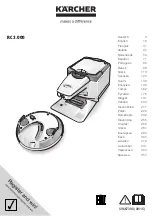
9 Appendix
25
assembly
3U-19" case for rack mounting with handles
left ½-
19” half wired for testo MD19-3E primary diluter plug-in
evaporation tube mounted on rear side of 19” case
dimensions (w
∙
h
∙
d): 485
∙
146
∙
530
mm
weight
without testo MD19-3E primary diluter
ca. 13.5
kg
with integrated testo MD19-3E
: ca. 19.1
kg
complete withtesto MD19-3E and CU-2:
ca. 26.7 kg
operating
conditions
T
amb
: 10 ... 40 °C
0...80% relative humidity, max. 80%@30°C, linearly degrading to
50%@40°C, non-condensing
calibration
• standard calibration with CAST soot particles, 80
nm,
testo ASET15-1 operated with cold (ambient temperature) and heated
evaporation tube
• UN-ECE R83 calibration possible with integrated testo MD19-3E
Rotating Disk
diluter
conformity
testo ASET15-1 Air Supply Evaporation Tube is in conformity with the
following standards or other related documents:
EN 61326-1
:
2006
/
B1
Electrical equipment for measurement, control
and laboratory use. EMC requirements.
EN 61010-1
:
2001 Safety requirements for electrical equipment
for measurement, control and laboratory use.
and therefore is in conformity with the following European Directives in
their current versions:
2014/30/EU Electromagnetic compatibility
2006/95/EG
Low voltage directive
9.3.
Thermophoretic Losses
Thermophoretic particle losses occur due to the temperature gradient when a hot aerosol passes
cool surfaces. This effect can be reduced by cooling down the aerosol quickly when it leaves the
hot area. In the testo ASET15-1 the effect appears in the aerosol tubing downstream the
evaporation tube and can be reduced significantly by setting a higher secondary dilution factor
which means a large amount of cool air is added to the hot measuring gas cooling it down
immediately when it comes from the evaporation tube 34) and enters the mixing chamber 37).
The diagram in Fig. A.1 shows the typical thermophoretic losses in the evaporation tube heated
up to 300°C measured on testo ASET15-1 with 82
nm soot particles. Each testo ASET15-1 is
calibrated individually for most accurate loss determination.
Fig.A.1: secondary dilution flows






































